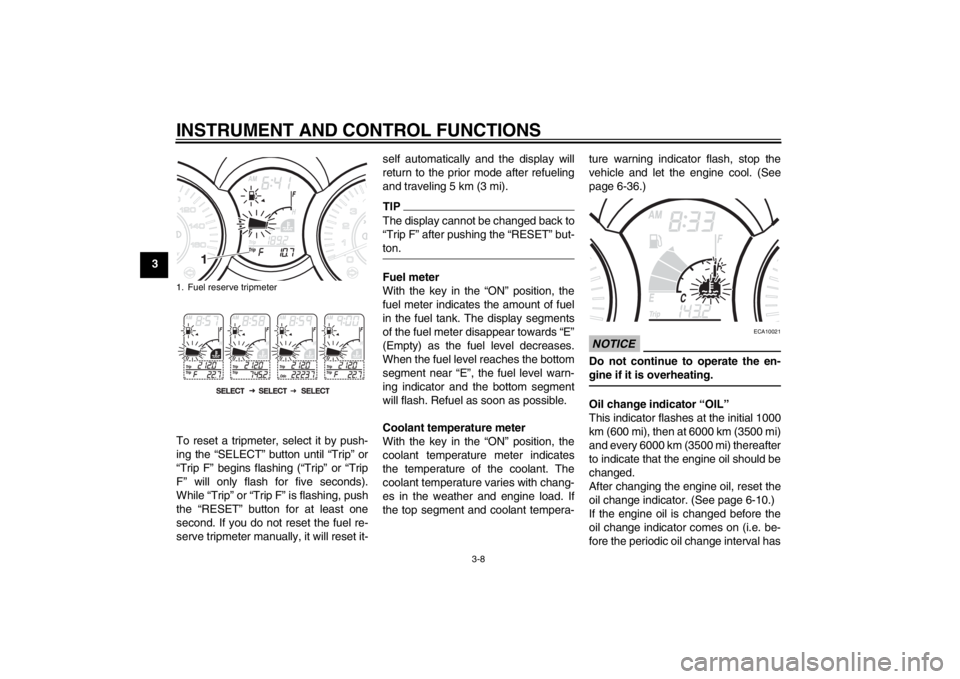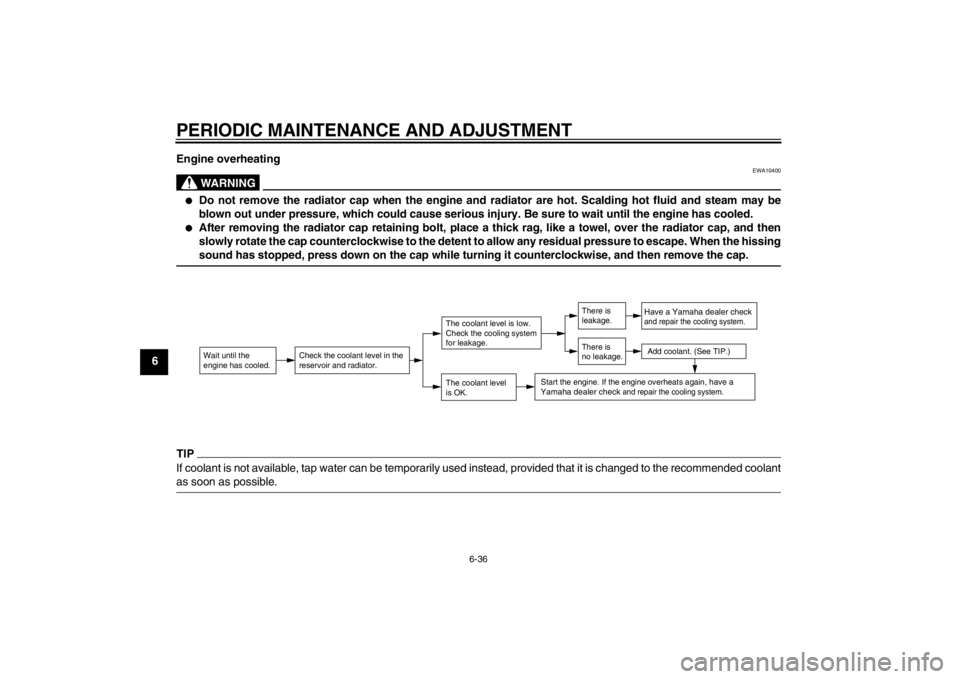engine overheat YAMAHA XMAX 125 2013 Owners Manual
[x] Cancel search | Manufacturer: YAMAHA, Model Year: 2013, Model line: XMAX 125, Model: YAMAHA XMAX 125 2013Pages: 96, PDF Size: 4.83 MB
Page 26 of 96

INSTRUMENT AND CONTROL FUNCTIONS
3-8
3
To reset a tripmeter, select it by push-
ing the ÔÇťSELECTÔÇŁ button until ÔÇťTripÔÇŁ or
ÔÇťTrip FÔÇŁ begins flashing (ÔÇťTripÔÇŁ or ÔÇťTrip
FÔÇŁ will only flash for five seconds).
While ÔÇťTripÔÇŁ or ÔÇťTrip FÔÇŁ is flashing, push
the ÔÇťRESETÔÇŁ button for at least one
second. If you do not reset the fuel re-
serve tripmeter manually, it will reset it-self automatically and the display will
return to the prior mode after refueling
and traveling 5 km (3 mi).
TIPThe display cannot be changed back to
ÔÇťTrip FÔÇŁ after pushing the ÔÇťRESETÔÇŁ but-
ton.Fuel meter
With the key in the ÔÇťONÔÇŁ position, the
fuel meter indicates the amount of fuel
in the fuel tank. The display segments
of the fuel meter disappear towards ÔÇťEÔÇŁ
(Empty) as the fuel level decreases.
When the fuel level reaches the bottom
segment near ÔÇťEÔÇŁ, the fuel level warn-
ing indicator and the bottom segment
will flash. Refuel as soon as possible.
Coolant temperature meter
With the key in the ÔÇťONÔÇŁ position, the
coolant temperature meter indicates
the temperature of the coolant. The
coolant temperature varies with chang-
es in the weather and engine load. If
the top segment and coolant tempera-ture warning indicator flash, stop the
vehicle and let the engine cool. (See
page 6-36.)
NOTICE
ECA10021
Do not continue to operate the en-
gine if it is overheating.Oil change indicator ÔÇťOILÔÇŁ
This indicator flashes at the initial 1000
km (600 mi), then at 6000 km (3500 mi)
and every 6000 km (3500 mi) thereafter
to indicate that the engine oil should be
changed.
After changing the engine oil, reset the
oil change indicator. (See page 6-10.)
If the engine oil is changed before the
oil change indicator comes on (i.e. be-
fore the periodic oil change interval has
1. Fuel reserve tripmeterU2ABE2E0.book Page 8 Thursday, August 30, 2012 2:36 PM
Page 47 of 96

OPERATION AND IMPORTANT RIDING POINTS
5-4
5
EAU16820
Tips for reducing fuel con-
sumption Fuel consumption depends largely on
your riding style. Consider the following
tips to reduce fuel consumption:ÔŚĆ
Avoid high engine speeds during
acceleration.
ÔŚĆ
Avoid high engine speeds with no
load on the engine.
ÔŚĆ
Turn the engine off instead of let-
ting it idle for an extended length of
time (e.g., in traffic jams, at traffic
lights or at railroad crossings).
EAU16830
Engine break-in There is never a more important period
in the life of your engine than the period
between 0 and 1000 km (600 mi). For
this reason, you should read the follow-
ing material carefully.
Since the engine is brand new, do not
put an excessive load on it for the first
1000 km (600 mi). The various parts in
the engine wear and polish themselves
to the correct operating clearances.
During this period, prolonged full-throt-
tle operation or any condition that might
result in engine overheating must be
avoided.
EAUS1840
0ÔÇô500 km (0ÔÇô300 mi)
Avoid prolonged operation above 5000
r/min.
500ÔÇô1000 km (300ÔÇô600 mi)
Avoid prolonged operation above 7500
r/min. NOTICE: After 1000 km (600
mi) of operation, be sure to replace
the engine oil, final transmission oil
and the oil filter element.
[ECA12931]
1000 km (600 mi) and beyond
The vehicle can now be operated nor-
mally.NOTICE
ECA10310
ÔŚĆ
Keep the engine speed out of
the tachometer red zone.
ÔŚĆ
If any engine trouble should oc-
cur during the engine break-in
period, immediately have a
Yamaha dealer check the vehi-
cle.
U2ABE2E0.book Page 4 Thursday, August 30, 2012 2:36 PM
Page 84 of 96

PERIODIC MAINTENANCE AND ADJUSTMENT
6-36
6Engine overheating
WARNING
EWA10400
ÔŚĆ
Do not remove the radiator cap when the engine and radiator are hot. Scalding hot fluid and steam may be
blown out under pressure, which could cause serious injury. Be sure to wait until the engine has cooled.
ÔŚĆ
After removing the radiator cap retaining bolt, place a thick rag, like a towel, over the radiator cap, and then
slowly rotate the cap counterclockwise to the detent to allow any residual pressure to escape. When the hissing
sound has stopped, press down on the cap while turning it counterclockwise, and then remove the cap.
TIPIf coolant is not available, tap water can be temporarily used instead, provided that it is changed to the recommended coolant
as soon as possible.
Wait until the
engine has cooled.
Check the coolant level in the
reservoir and radiator.
The coolant level
is OK.The coolant level is low.
Check the cooling system
for leakage.
Have a Yamaha dealer checkand repair the cooling system.Add coolant. (See TIP.)
Start the engine. If the engine overheats again,
have a
Yamaha dealer check
and repair the cooling system.
There is
leakage.
There is
no leakage.
U2ABE2E0.book Page 36 Thursday, August 30, 2012 2:36 PM